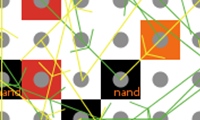Accept
Details & settings
This website uses cookies for cookie consent and statistics.

What is the difference between particles and bits?
Water molecules can form crystals under suitable conditions. Are there also effects that lead to spontaneous structure formation of information in data
processing systems?
This project focuses on a novel kind of computer science, an interdisciplinary concept that is based on self-organization of information. This concept is the opposite of classical computer systems and it would be ideal for parallel computing and for solving nonlinear or complex problems. Current research on self-organized algorithmic structures in quantum systems shows how novel this approach is.
I identify the conditions that lead to self-organization of physical and biological systems and then I transfer these conditions of self-organization to data processing systems. The resulting model resembles that explaining the formation of fields and forces from the basic properties of particles in physics.
Based on my findings, I develop an evolutionary algorithm that optimizes a population of reaction chambers with respect to a target property. Each reaction chamber contains a simulation. For now, I am hoping to achieve self-organized logical structures that perform a data processing function.
So far, I was able to verify that the evolutionary algorithm works and I also succeeded in demonstrating self-organization of states in logical structures. I am currently working on a simulation of self-organized logical gates.
In order to allow the application to quantum systems, I am planning a quantum model of interaction of information. Therefore, I am looking into analogies between information theory, quantum electrodynamics and thermodynamics.